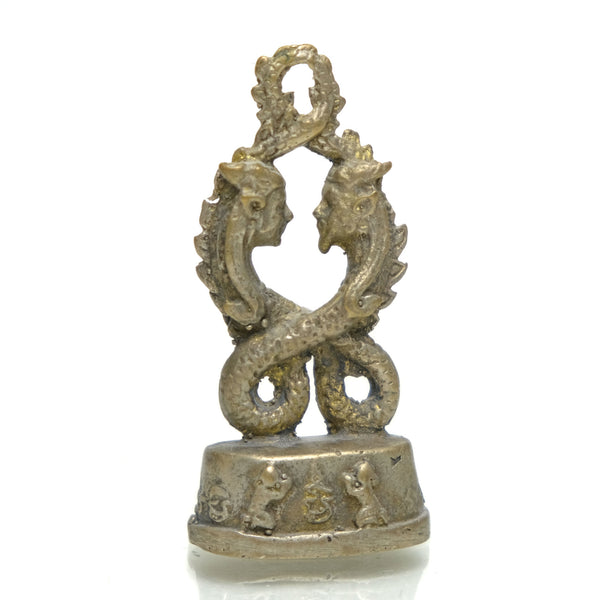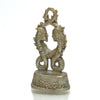See more: amulet
Naga King and Queen Couple Love Amulet
$ 135.00
- Naga King and Queen Couple Love Amulet
- Measures approx. 3" x 1 1/2" x 7/8"
- Material: cast pewter
- In Hinduism, Buddhism and Jainism, the Naga or Nagi are Divine, Semi-Divine Deities of half-human half-serpent beings that reside in the Netherworld (Patala) and can occasionally take human form. They are principally depicted in three forms: wholly human with snakes on the heads and necks; common serpents, or as half-human half-snake beings. A female Naga is a "Nagi", "Nagin", or "Nagini".
- They are common and hold cultural significance in the mythological traditions of many South Asian and Southeast Asian cultures.
- Nagaraja is seen as the King of Nagas. Nagaramma is the name of the Queen of the Nagas.
- The mythological serpent race that took form as cobras often can be found in Hindu iconography. The Nāgas are described as the powerful, splendid, wonderful and proud Semi-Divine race that can assume their physical form either as human, partial human-serpent or the whole serpent.
- Their domain is in the enchanted underworld, the underground realm filled with gems, gold and other earthly treasures called Naga-loka or Patala-loka. They are also often associated with bodies of waters — including rivers, lakes, seas, and wells — and are guardians of treasure.
- Their power and venom made them potentially dangerous to humans. However, they often took beneficial protagonist role in Hindu mythology, such as in Samudra manthan mythology, Vasuki, a Nāgarāja who abides on Shiva's neck, became the churning rope for churning of the Ocean of Milk. Their eternal mortal enemies are the Garudas, the legendary Semi-Divine birdlike-Deities.
- Vishnu is originally portrayed in the form sheltered by Śeṣanāga or reclining on Śeṣa, but the iconography has been extended to other deities as well. The serpent is a common feature in Ganesha iconography and appears in many forms: around the neck, used as a sacred thread wrapped around the stomach as a belt, held in a hand, coiled at the ankles, or as a throne. Shiva is often shown garlanded with a snake. Maehle (2006: p. 297) states that "Patanjali is thought to be a manifestation of the serpent of eternity".
- In Buddhism, the Naga Mucalinda shelters Gautama Buddha (Buddha in Naga Prok attitude) at Wat Phra That Doi Suthep in Chiang Mai, Thailand.
- As in Hinduism, the Buddhist Nāga generally has the form of a great cobra, usually with a single head but sometimes with many. At least some of the Nāgas are capable of using magic powers to transform themselves into a human semblance. The Nāga is sometimes portrayed as a human being with a snake or dragon extending over his head. One Nāga, in human form, attempted to become a monk; and when telling it that such ordination was impossible, the Buddha told it how to ensure that it would be reborn a human, and so able to become a monk.
- Origin is Thailand




